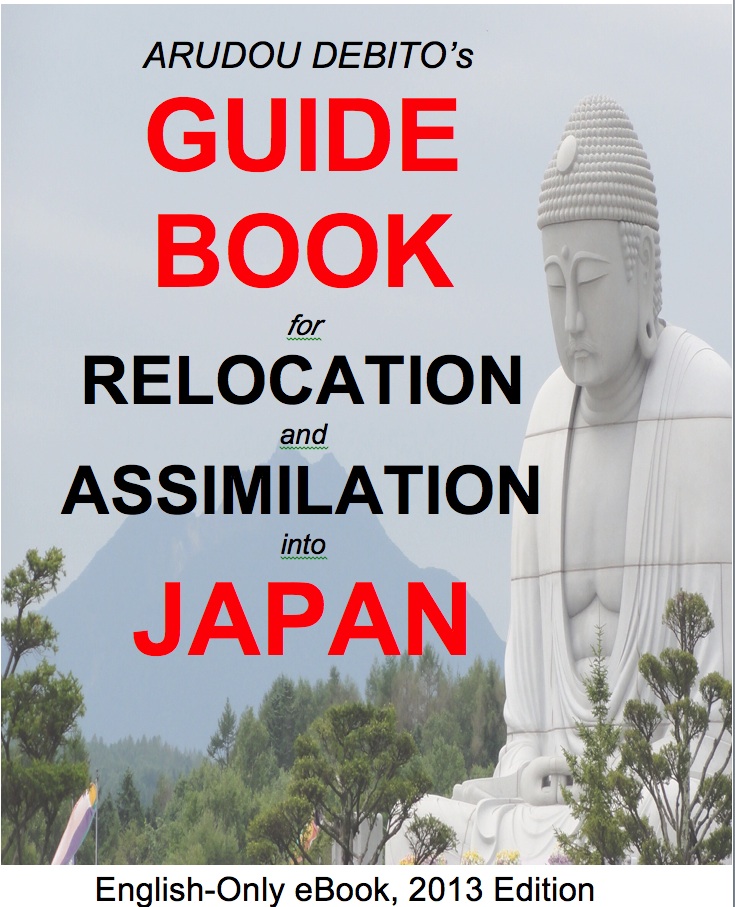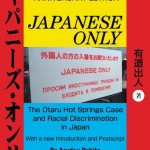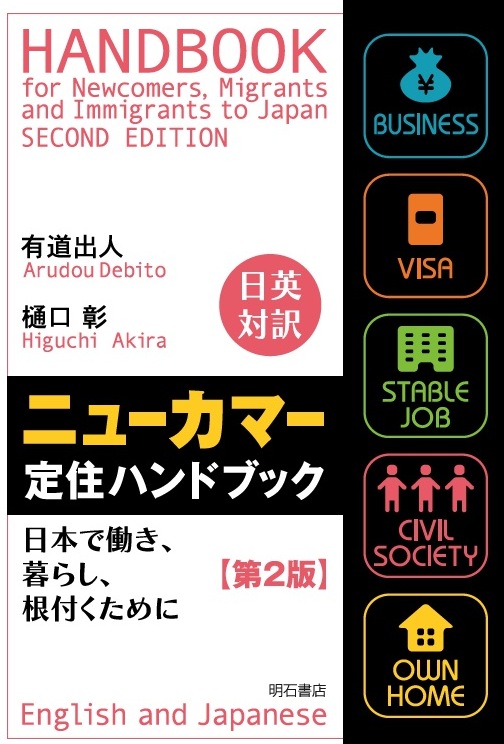mytest
Books, eBooks, and more from Dr. ARUDOU, Debito (click on icon):





![]()


UPDATES ON TWITTER: arudoudebito
DEBITO.ORG PODCASTS on iTunes, subscribe free
“LIKE” US on Facebook at http://www.facebook.com/debitoorg
https://www.facebook.com/embeddedrcsmJapan
http://www.facebook.com/handbookimmigrants
https://www.facebook.com/JapaneseOnlyTheBook
https://www.facebook.com/BookInAppropriate
If you like what you read and discuss on Debito.org, please consider helping us stop hackers and defray maintenance costs with a little donation via my webhoster:

All donations go towards website costs only. Thanks for your support!
Hi Blog. When Japan’s first actual law against hate speech was passed in January this year, critics (naturally) decried it as a means to stifle freedom of speech. I took exception to that, saying that it was a step in the right direction, at least. Recent articles in the Mainichi Shinbun seem to bear that out. Here is one of three, talking about the positive effects of the law, where once-daily hate rallies are down, xenophobic language is softened and made less normalized, administrative organs now have means of enforcement, and even court cases are ruling in favor of targeted victims. Good. Read on. Dr. ARUDOU, Debito
/////////////////////////
From: JK
Hi Debito. Have a look here:
1 month after anti-hate speech law adopted, marches down, language softened
http://mainichi.jp/english/articles/20160724/p2a/00m/0na/003000c
“The thinking of those putting out hate speech and the (essential) content of what they say may not change, but at least on the surface we can see the effects of the countermeasures. It seems (for example) that the organizers are not allowing demonstrators who often say extremist things to have bullhorns.”
“Preventing hate marches through the law thus depends not on cracking down on such actions, but on government policies that put a stop to discrimination.”
Seems like the law is doing a decent job of treating the symptoms, but is obviously unable to deal with the underlying problem due to the absence of an anti-racial discrimination law on the books.
In other news, the German Justice Minister wants harsher action against hate speech online:
http://www.breitbart.com/london/2016/07/19/german-justice-minister-harsher-action-hate-speech/
Regards, JK
Full article:
===========================
1 month after anti-hate speech law adopted, marches down, language softened
July 24, 2016 (Mainichi Japan)
http://mainichi.jp/english/articles/20160724/p2a/00m/0na/003000c
A protest banner reading “sever Japan and South Korean relations” and a counter “anti-racism” protest’s banner written in English are seen in Chuo Ward, Tokyo, on June 19, 2016. (Photo credit: Mainichi)
One month after a new anti-hate speech law was put into effect, and following the introduction of the nation’s first local anti-hate speech ordinance in the city of Osaka on July 1, the Mainichi Shimbun investigated how much effect these new measures have had in putting an end to hate-speech protests.
A citizen’s group that accuses the Osaka ordinance of “discriminating against Japanese” and was planning a demonstration in front of the Osaka Municipal Office on July 12 listed the following among its notices for its demonstrators: “Please don’t use placards with extreme content,” and “No flags with swastikas or other things that will invite misunderstanding.”
The demonstration was canceled due to rain, so what exactly was meant by “extreme content” is unknown, but it seems likely the group was trying to limit language that insults and rejects ethnic Koreans in Japan.
Mun Gong Hwi, an ethnic Korean, is head of the secretariat of “Hate Speech o Yurusanai! Osaka no Kai” (don’t allow hate speech! Osaka group), which has applied based on the Osaka ordinance for recognition as a target of hate speech. Mun says, “In a street demonstration by a hate group in April, there was a moment when one participant started to use blatantly offensive language to attack Koreans, and the organizers hurried to stop them. The number of hate demonstrations has also fallen greatly since around the time of the ordinance taking effect.”
Under the Osaka ordinance, if the mayor authorizes it, individuals or groups that have conducted hateful behavior toward others can have their names publicized, but so far this aspect of the ordinance has not been used. Mun adds, “The drop in (hate) demonstrations may just be because they are watching to see how things develop.”
In Ginza, Tokyo, where since around last year there has been a marked increase in hate demonstrations, there have also been changes since the new legal measures. During a demonstration on June 19, instead of banners insulting Koreans, protesters carried banners calling for severing relations between Japan and South Korea, apparently having chosen to avoid ethnically-charged language and instead place emphasis on their political argument.
Masayuki Watanabe, associate professor at Daito Bunka University, who has been urging Ginza commerce and industry associations and the ward assembly to take action against hate speech, says, “The thinking of those putting out hate speech and the (essential) content of what they say may not change, but at least on the surface we can see the effects of the countermeasures. It seems (for example) that the organizers are not allowing demonstrators who often say extremist things to have bullhorns.”
The response of police and the government administrations to hate marches has also changed. On June 5, just after the execution of the new law, the Kawasaki Municipal Government refused to give permission for a park to be used for a protest targeting the social welfare corporation “Seikyu-sha,” which gives support to the many ethnic Koreans living in the city’s Sakuramoto district. Additionally, the Kawasaki branch of the Yokohama District Court called the hate speech demonstrations “an illegal violation of human rights” and prohibited them from being held near the Seikyu-sha building.
Kanagawa Prefectural Police gave permission for the demonstration to be held in a different street location, but protesters staged a sit-in. The police urged the organizers to call off the demonstration for safety reasons, and it was canceled.
Tomohito Miura, the head of Seikyu-sha’s secretariat, says, “Before the anti-hate speech law was created, the police wouldn’t even tell us the routes planned for the demonstrations, and it was we who were treated like an illegal group. The police wouldn’t protect us from hate demonstrations in our neighborhoods, and government services would say, ‘There is only so much we can do under the current law.’ We were on the receiving end of these three layers of damage.” He was complimentary, however, toward the efforts of government organs, the judiciary, police and citizens since the passage of the law, saying, “It is a definite step forward that we were able to stop the demonstration.”
While vulgar insults from these hate marches may be disappearing from the streets, the question remains whether the new law will be effective in combatting discrimination. In deference to the Constitution’s guarantee of freedom of speech, the law does not forbid anything or include any punishments, but it makes it the national government’s responsibility to set up help for victims of hate speech and to work to educate and provide awareness to the public to stop the speech from occurring. It also calls on municipal governments to work toward these goals. Preventing hate marches through the law thus depends not on cracking down on such actions, but on government policies that put a stop to discrimination.
The Ministry of Justice’s Human Rights Bureau dispatched employees not only for the planned Kawasaki demonstration, but also for ones in the cities of Fukuoka and Osaka after the new law went into effect. Using tools such as videos and posters, they are trying to educate people about hate speech. However, the bureau emphasizes, “The law does not involve applying any kind of legal effect when there is a case of hate speech.”
Following the implementation of the new law, the Ministry of Education, Culture, Sports, Science and Technology instructed prefectural boards of education to take “appropriate responses.” When asked what kind of education is an appropriate response to the law, the ministry’s Social Education Division said, “Efforts that are adapted to the circumstances, such as whether there are many foreigners in an area, are needed. However, we mustn’t stir up settled problems through this education.” While there is some truth to what the division says, it does seem they are still trying to find their footing on how to proceed.
Will other parts of Japan do the same as the Osaka Municipal Government and establish local ordinances against hate speech? When asked about specific future policies on hate speech, the human rights and gender-equality section of the Kawasaki Municipal Government was tight-lipped, saying its policy was being carried out “at the discretion of the mayor.” When pressed, a representative said, “Regarding things like refusing permission to allow use of the park (for the hate demonstration), I hear there is a movement to sue the municipal government for discriminating against Japanese people. We don’t want to reveal our plans.” Apparently, like the demonstrators, the government side is watching to see what the other does.
If another hate demonstration is planned in Kawasaki, will the citizens have no choice but to stage a sit-in and wait for police intervention? Miura says, “The fact that police gave permission for the June demonstration to be held in the street shows the current limits (of the law). We can’t ask the police and government services to do everything. Next time, we will have to stop the demonstration in a different way. The work to overcome the limits of the law has just begun.”
Not limited to just fighting against hate speech, Miura says Seikyu-sha will work with the municipal government to advance effective ordinances and guidelines that promote the coexistence of different cultures.
Regarding the city of Osaka, which has its own anti-hate ordinance, Mun says, “We don’t yet know the extent of the effects of the anti-hate law or the ordinance. This is why we want to use the ordinance as much as possible and discover exactly what it can do and what it can’t. Based on that, if necessary, we want to pursue revision of the ordinance to restrict hate speech itself.” This position of wanting to observe what happens and then compensate for any deficiencies in the anti-hate legislation is one shared by Miura and the others at Seikyu-sha.
Always accompanying the hostile feelings of the hate demonstrations is the shadow of war. The targeting of the Sakuramoto area was triggered by a protest in September last year by elderly ethnic Koreans against the bills for the new security laws. Wearing traditional Korean garb, the protesters were based out of the “Fureai-kan,” a facility managed by Seikyu-sha.
“The hate demonstration was clearly in revenge for that,” says Miura.
One of the participants in the anti-security laws protest, first-generation Korean immigrant Kim Bang Ja, 85, is also a student of literacy at the Fureai-kan. She was about 5 when she came to Japan, following her father who worked in a coal mine in Yamaguchi Prefecture. Busy with looking after her younger sister and doing household chores, she says she was only able to go to school for about one year. When the anti-hate law was passed in May this year, she was sitting as an observer in the Diet. She wrote her impressions about the law in a composition in her literacy class.
After describing how she disliked being insulted with foul language, she wrote, “Let’s stop doing that kind of thing and get along.” Although overall the writing was inconsistent, for this part alone it was particularly large and strong.
“My hand was shaking because I was writing in ink,” says Kim, adding, “If people talk they can come to an understanding. We have to get along with each other and not hate others.”
Will these words get through to those who participate in the hate demonstrations? The first step to realizing the ideals put forward in the anti-hate law is surely having communication between the two sides.
ENDS
Japanese version:
==============================
特集ワイド
ヘイト対策法施行1カ月の現場を見る 差別許さぬ包囲網 デモ隊は規制警戒、侮蔑・排外的表現控え
毎日新聞2016年7月15日 東京夕刊
http://mainichi.jp/articles/20160715/dde/012/040/015000c
6月19日、銀座で行われたデモでは、「日韓断交」という標語が目立った。手前の沿道からは市民が「反レイシズム」と英語で書かれたプラカードを掲げ抗議した=東京都中央区で2016年6月19日、井田純撮影
特定の人種や民族に対しての差別的な言動解消を目指すヘイトスピーチ対策法施行から1カ月が過ぎた。1日には大阪市で全国初のヘイトスピーチ抑止条例が施行された。法律や条例といった規制で、差別はどこまでなくなるのか。ヘイトデモの現場を歩きながら考えた。【井田純】
「過激な内容のプラカードはご遠慮ください」「ハーケンクロイツ(ナチス・ドイツが用いたシンボルマーク)など、誤解を招くような旗は禁止」
大阪市ヘイトスピーチ抑止条例は「日本人差別法だ」と主張する市民団体が12日に市役所前で予定していた街頭宣伝活動の案内文には、こんな注意事項があった。活動は雨で中止になったため、「過激な内容」が何を意味するかは分からないが、在日コリアンを侮辱したり、排斥したりといった言動は控えようという姿勢がうかがえる。
「4月に市中心部で行われたヘイトグループの街宣で、参加者の一人が『朝鮮人が』と露骨な表現で攻撃を始めると主催者があわてて制止する場面があった。デモの回数も条例施行前後からめっきり減っています」
こう話すのは、抑止条例に基づき被害申し立てを行った「ヘイトスピーチを許さない!大阪の会」の事務局長で在日コリアンの文公輝(ムンゴンフィ)さんだ。条例は市長が認定すればヘイト行為をした個人名や団体名などが公表されるが、まだその条例適用事例はない。「デモが減ったのも、ただ単に様子を見ているだけかもしれません」
昨年あたりから、ヘイトデモが目立つようになった東京・銀座でも、変化が見られる。先月19日に行われたデモでは、在日コリアン罵倒のプラカードでなく、複数の「日韓断交」ののぼりが目立った。民族を排斥する表現を避けて、政治的主張に力点を置いたものと見られる。
銀座の商店会や区議にヘイト対策を働きかけている渡辺雅之・大東文化大准教授は「ヘイト側の考え方、中身は変わらないかもしれないが、少なくとも表面的には対策法の影響がうかがえる。主催者も、特に過激な発言が多い参加者には拡声機を持たせないようにしているようだ」と分析する。
警察や行政の対応も変わった。対策法施行直後の6月5日、在日コリアンが多く住む川崎市・桜本地区で、彼らの支援を続ける社会福祉法人「青丘社」をターゲットにしたヘイトデモ計画に対し、市は同所近くの公園利用の不許可を決定。横浜地裁川崎支部はヘイトデモを「人格権に対する違法な侵害行為」と認定し、法人近くでのデモを禁止した。神奈川県警は市内の別の地区で道路使用を許可したが、抗議する市民が座り込みを行い、安全上の理由から中止するよう県警が主催者に働きかけ、デモは中止になった。
「対策法ができる前は、警察からデモコースも教えてもらえず、こちらが不法集団のように扱われてきた。自分たちの生活圏で行われるヘイトスピーチ、人権被害から守ってくれない警察、『現行法でできることに限界がある』という行政。この『三重の被害』を受けてきたんです」。青丘社の三浦知人事務局長はこう振り返りながらも、法施行後の行政、司法、警察、市民による手探りの努力について「結果としてデモを阻止できたのは、確実な一歩です」と評価した。
口汚い罵倒は街頭から消えつつある。法で差別解消が実現されるのだろうか。
行政の限界、市民が埋める取り組み
対策法は、憲法が保障する「表現の自由」を尊重し、禁止規定や罰則のない理念法だ。運用については、相談体制整備や教育、啓発活動を国の責務とし、自治体にも同様の努力を求めている。抑止効果は、行為への取り締まりではなく、差別をなくす行政の政策にかかっているのだ。
法務省人権擁護局は、川崎のほか施行後に行われた福岡、大阪でのヘイトデモの現場周辺にも職員を派遣。映像やポスターなどを使った啓発活動を実施している。だが「具体的にヘイトスピーチにあたる行為があった場合、それに対して何らかの法律効果を生じさせる、という構成の法律ではない」と強調する。
対策法施行を受け、都道府県の教育委員会に「適切な対応」を求める通達を出した文部科学省。同省社会教育課に、どんな啓発教育が適切なのか聞くと、「外国人が多い地域かどうかなど、事情に応じた取り組みが必要。教育を通じて『寝た子を起こす』ことになってもいけない」との回答。一理あるが、まだ手探りの感は否めない。
大阪市のような条例制定の動きが、各地に広まっていくのだろうか。川崎市の人権・男女共同参画室に今後の具体的な施策を尋ねると、「市長判断で行われていることなので」と口が重い。食い下がると、「公園使用不許可などに関して、日本人を差別した、と市を相手取った訴訟を起こす動きもあると聞く。手の内を明かすようなことは……」と警戒心をあらわにした。相手の出方をうかがっているのは行政も同じようだ。
川崎市で再びヘイトデモが計画されたら、また、市民が道路に座り込み、県警の仲介を待つしかないのだろうか。前出の三浦さんは「6月のデモで、警察が道路使用を許可したことが今の限界を示している。何でも警察や行政に求めることはできない。今度は別の形で止めなければ。限界を埋める作業は始まったばかり」と話す。ヘイトスピーチ規制に限らず、多文化共生に向けた条例やガイドラインなど実効性のある取り組みを行政と連携しながら模索するという。
一方、独自に条例を持つ大阪市の今後について文さんは「どこまでが対策法の効果か、条例の影響かまだ分からない。だからこそ、我々は条例をできるだけ活用し、具体的にどんな効力を持つのか、どういう点で無力なのかを見極めていきたい。その上で、必要ならヘイトスピーチ自体を規制する条例改正も求めたい」と語る。実例を見ながら、対策法の不十分な領域を補っていこうという方向性は三浦さんたちと共通する。
在日1世「なかよくしよう」
ヘイトデモが起きる敵対感情には、戦争の影がつきまとう。桜本地区が標的になったのは、青丘社が運営する「ふれあい館」を活動拠点とする在日コリアンの高齢者が昨年9月、安全保障関連法案反対デモをチマ・チョゴリ姿で行ったのがきっかけだ。「ヘイトデモは明らかにその仕返しだった」と三浦さんは言う。
安保法案反対デモに参加した一人で、在日コリアン1世の金芳子(キムバンジャ)さん(85)は、ふれあい館の識字学級に通う生徒でもある。山口県の炭鉱労働者だった父を追って日本に渡ったのは5歳のころ。妹の子守りや家事で忙しく、学校には1年程度しか通えなかったという。対策法が成立した5月、国会で傍聴した時の思いを教室で書いた作文を見せてくれた。
汚い言葉でののしられるのは嫌だという気持ちの後に、「もうそろそろそんなことはやめにして、なかよくしましょうよ」とある。不ぞろいの文字は、ここだけひときわ大きく力強い。「墨で書いたから手が震えたよ」と恥ずかしがりながら、金さんは言った。「やっぱし人間は話せばわかる。人を憎まないで仲ようするしかない」
ヘイトデモに加わった人たちに、この言葉が届く日が来ると信じたい。対策法の理念を現実にしていく過程はきっと対話から始まる。
ENDS
///////////////////////////////////
Do you like what you read on Debito.org? Want to help keep the archive active and support Debito.org’s activities? We are celebrating Debito.org’s 20th Anniversary in 2016, so please consider donating a little something. More details here.
10 comments on “Mainichi: After Osaka hate speech ordinance adopted, daily xenophobic marches decrease, hateful language softened”
Ahh, I see, it’s all my fault. When I see right wingers marching and shouting racist things with swastika flags, I’m ‘misunderstanding’.
Right…
@Jim, one of my most satifying moments in Japan was to see the swastika clad, brown shirted J nerd I was glaring at in Akihabara being taken away by the police in a police car. Then again, maybe it was for “his own safety” as the NJ “tourist” was looking scary.
In the 80s Nazi, chic in Japan was in full swing. It was explained to me that it was “just fashion”, along with “We Japanese can choose (what parts of western culture We appropriate)”.
Yeah right.
The problem with this Osaka ordinance is that it doesn’t have any teeth in it, they are just going through the motions again to appear progressive because they know that all eyes will be on Japan for the 2020 olympics and when thats over with then back to business as usual with no enforcement or penalties etc. We have seen it time and time again over here and we will continue to see it because every thing turns in a revolving cycle over here to appease the masses.
13 year old Korean boy tourist got hate attacked by Japanese man in Osaka
https://www.reddit.com/r/korea/comments/56xjx1/south_korean_embassy_in_japan_issues_a_travel/
Foreigners blamed for dirtying up Japanese train by being there, after a angry Japanese man makes a commotion that there were too many foreigners in the train.
http://www.japantimes.co.jp/news/2016/10/11/national/nankai-train-conductor-chided-apologizing-presence-non-japanese-passengers/#.V_0VMJMrIUE
Now that they’re cracking down on hate somewhat, the hate is now going lot more underground.
@ Read It #4
Osaka seems to have a real problem keeping an Omotenashi tatemae on its racism recently:
Wasabi ‘terror’, racist announcement on the train, attack on Korean minor, train company writing ‘Kim Chon’ on a Korean customers travel card on the assumption that he couldn’t read katakana- all in what? One week?
@JDG #5
Any links to the the travel card “Kim Chon” story?
@ Andrew In Saitama #6
Sure, here is a link with photo of offending item (in Japanese);
http://pinfluencer.net/kip/
@Jim #7
I love it! Even in chronicling the event, the author of that Web site outright states he dislikes Koreans, concluding with “even if you hate Koreans, it’s still not okay to do them harm.” What an inspiring sentiment.
@ JDG #7
Thanks for the link. I loved the comment that it was probably just a misunderstanding when the staff (communicating in English) mis-heard the name.
It seems that “It was a misunderstanding” trumps all in Japan.
@ Andrew In Saitama #9,
Isn’t that always the way?
Every time any Japanese public figure is called out on their racists comments, they claim that they were ‘misunderstood’.
Perhaps the misunderstanding is theirs; they don’t actually know what racism is, and are blissfully unaware they are racists.